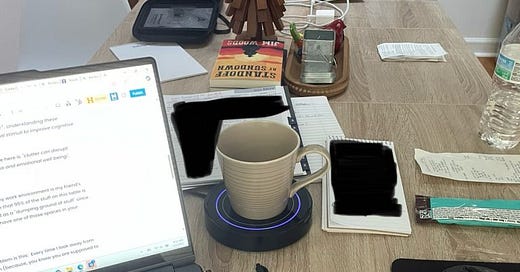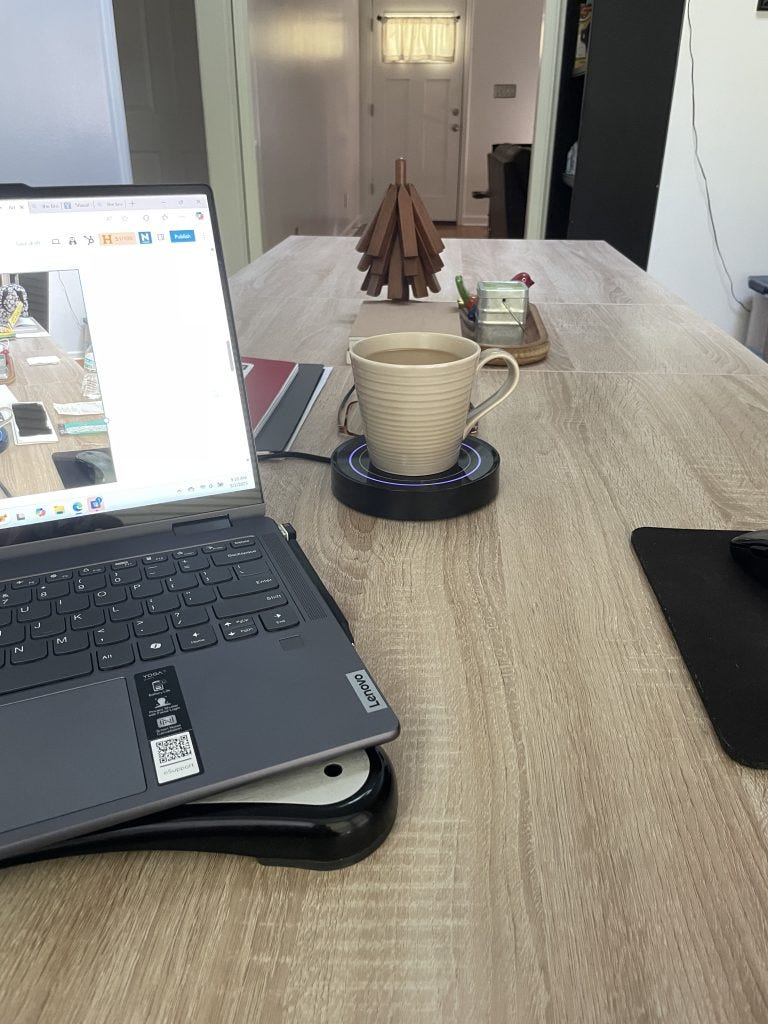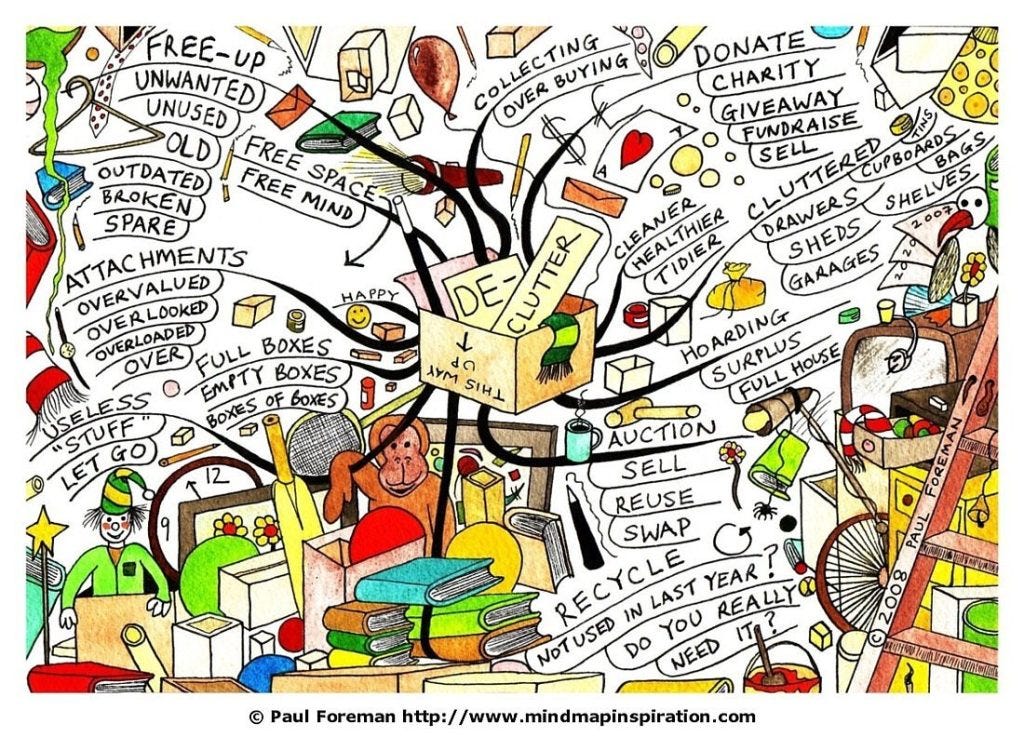Special “thank you” shout out to
for writing a note that inspired this post!Our brains work hard every day to keep us alive but also as the filter of information. We use our five senses to collect information from our environments, and the brain filters it.
I don't know about you, but my brain operating system constantly runs with about twenty tabs open at all times, and I spend a lot of time during the day recalling information from the memory bank. With any luck, all the information I learn in a day gets filed somewhere in my memory.
When we think of clutter, most often we conjure an image of all the stuff we have laying around on flat surfaces. As in, "the kitchen counter is very cluttered". Clutter is defined as a crowded or confused collection. (Merriam-Webster). I find it interesting that there's also this definition: interfering radar echoes caused by reflection from objects (as on the ground) other than the target. But for now, we are going to focus on the "crowded and confused" part of the definition.
Particularly with the focus on visual clutter.
If you google, "The Brain Science of Visual Clutter", you'll get 11,200,000 results. If you skim through those results, the information is really fascinating and once you understand it, it makes a lot of sense! For purposes of summarization, I'll highlight a few articles I found.
First, a definition of visual clutter: (this was the first thing that popped up on my google search)
Visual clutter significantly impacts brain function by altering information flow in the primary visual cortex. Research indicates that the location of visual clutter within our field of vision plays a crucial role in how effectively visual information is processed2. This clutter can disrupt neural pathways, affecting focus and emotional well-being, as it creates a flood of stimuli that can feel like background noise4. Understanding these effects can help in managing visual stimuli to improve cognitive performance.
The phrase that stood out for me here is "clutter can disrupt neural pathways affecting focus and emotional well being".
Some of the other headlines that stood out in my google search:
I restrained myself from going down the rabbit hole on these but in case you are interested -
Visual Clutter" Affects Brain Processing - Technology Networks
How Visual Clutter Disrupts Information Flow in the Brain (neurosciencenews.com)
Let's refocus back to the blog and look at an example:
I'm traveling this week, so my work environment is my friend's kitchen table. I'll note here that 95% of the stuff on this table is mine, the table has served as a "dumping ground of stuff" since I've been here.
I bet you have one of those spaces in your house, too, right?
The visual clutter problem is this: Every time I look away from my computer screen (because, you know you are supposed to that frequently, right?) I see something on this table and my brain shifts focus to that thing. Whatever my eyes see first become a distraction - my brain goes "Oh, I see that protein bar wrapper, I should throw that away." If I choose in that moment to get up from my work (in this case, writing) and put the protein bar wrapper in the trash, my brain focus has shifted away from writing and to the actions to throw the wrapper away. Odds are that since I got up to go to the trash can, I'd get distracted by something else that needs to be done and now my brain is no longer focused on writing but on all the other things. Distractions, ugh.
So, what happens if I clear the clutter entirely?
Well, first I need to set a timer - five minutes should work. I like to play the game of "beat the timer" and hyper focus on ONE task. I start at one end of the table and work my way to the end. Items that stay on the table get straightened out, items that don't belong on the kitchen table get put away - yes, put away, not just relocated to another flat surface.
Take a minute to look at both photos again - the before and the after. You should feel a certain way in your brain looking at the before and the after.
The before picture is chaos, the after picture is calm.
Do you know what your brain prefers? CALM
And yes, I cleaned the table while I made another cup of coffee!
In this article from news.Yal.edu, the author discusses a phenomenon called "visual crowding" :
"Too much stuff in the periphery of our vision can make it difficult to identify what we’re seeing. Yale researchers now know how that clutter affects the brain."
Go back and look at the photos again, in the "chaos" photo there are over 20 objects on the table. That's twenty things that my brain sees, processes and clutters up the brain with naming and thinking about those things.
In the second photo, there are less than ten items AND the items in the middle of the table stay there constantly - they belong there - so there's not much thinking about them my brain has to do. In fact, after several days of looking at them, my eyes and brain will become "blind" to them. This is known as "object blindness" and it's often why, we don't even really realize our spaces are over-cluttered. When we see the same clutter day in and day out, we became oblivious to it.
This is why people touch or pause in front of permanent signs -
When you bring the sense of touch, you help your brain remember that the sign is there.
For example, where my husband works, there are numerous safety signs on the walls. As he and others come into work, they make a habit of touching the sign, pausing for a moment to review the safety information.
Of course, my favorite "touch the sign" moment is this:
photo credit: Irishsportsdaily.com
If we don't take the time to pause and add the physical sense of touch to an item, we become oblivious to it.
But do we really? In a way we do, but also, our brain still sees and processes through all the objects that are clutter.
Why is a clutter-free, calm space important?
Think about spaces where a calm demeanor is required:
Doctors Offices
Emergency Rooms
Business Offices
Banks
Schools
Yoga Studios
If you think about it, each one of these spaces, ideally, are uncluttered. Sure, some if it is for safety but mostly it's because neat, clean organized spaces are better for nervous system regulation.
Have you ever walked into a space that was overly cluttered or chaotic and had a physical, visceral reaction? THAT is your nervous system going WHOA - I'm overwhelmed!!!
And yes, cleaning and organizing is a direct reflection of nervous system regulation. You know about rage cleaning, right?
Rage cleaning is the concept of using emotion (usually anger or frustration) to motivate an at-home cleaning spree. MarthaStweart.com
When our nervous systems are dysregulated - by anger, frustration, grief, etc. - we consciously or unconsciously use cleaning, purging, organizing as a means to calm the chaos. By calming the chaos of our physical spaces, we bring a sense of order and calm to our brain.
Trust me, I don't understand the science behind it, but it works. I've done rage cleaning enough times to know that when I'm experiencing negative emotions or nervous system dysregulation, the best thing for me to do is to clean, purge or organize something. I read somewhere that if you see someone in a "zone" of deep cleaning, organizing, or purging its best to leave them be because most likely, they are also working through a dysregulating emotion at the same time.
So now that you are aware that visual clutter causes stress, adds to the chaos of your already overworked brain AND there's a solution to fixing it, how do you start bringing it under control?
Well, you declutter.
Decluttering is another word for Minimalism.
The less stuff you have, the less clutter you have, period. So, start there - but know, decluttering is a process that takes not just physical energy but emotional energy. Let's face it, we all have too much stuff because we are emotionally attached to it.
About 5 or 6 years ago, I watched The Minimalists documentary and declared that we will become Minimalists. Well, not in the true sense of the word, but it certainly motivated me to get started on purging, decluttering and organizing. If you are new to Minimalism, start with watching the documentary.
Here's some quick tips to help you get started:
1. Pick ONE space at a time. Set a timer to work and go.
You will need three boxes or bins: trash, keep, donate/recycle.
Every object gets categorized in one of those boxes or bins.
If you have a particularly large room or space, start in the corners and work your way around the room. It's important in this step to take trash OUT to the trash and put the donate/recycle stuff in the car.
2. Sort first, then clean. Once you have all the objects sorted, clean your space.
3. Decide where everything goes - buy shelving or storage boxes if necessary. Personally, I like to put everything in a space and then buy shelving or boxes. Because it's too easy to get in the trap of "have a space, fill a space".
4. Put everything in its place, use labels as needed.
5. Maintain the space weekly or monthly.
Also, this process involves cycles - I've gone through each room and space in our home at least five times already. Each time, purging and decluttering more items that I felt like I had to keep during the first cycle.
Recognize the effect of clutter on your nervous system.
I know for a fact that my day starts off better if I walk into our kitchen and its clean. The counters are clean, there's no dirty dishes in the sink, there's no clutter on the countertops AND the counter tops have been wiped down and cleaned.
Additionally, my coffee cup is next to the coffee pot, and there's a pod waiting in the slot of the Keurig.
Years ago, I made the decision that our kitchen would be cleaned after dinner, every night. I'd say we do this abut 5 of the 7 nights of the week.
I also know for a fact that I work better when I walk into our home office and my desk is free of clutter from the day before.
When I work, I have notebooks, my calendar, a reports notebook (for my daily task list), pens, pencils, erasers, coffee cups, etc. on my desk. I have everything set out in a way where I can visually see what I am working on or working from (as in a list) so that I don't forget to do anything on my daily task list.
We have a rule in our family that NOTHING gets put on my desk by anyone other than me. I have my own system, and although it may look cluttered to others, it really messes up my workflow when a piece of mail or paper or anything else gets put on my desk.
So, just like we tidy the kitchen at the end of each day, I need to tidy my desk. My laptop gets put away, the pens/pencils get put back in the mug I use for a holder, the coffee cup gets returned to the kitchen, papers get neatly stacked, filed or shredded as necessary, my notebooks get stacked in the corner of my desk and my calendar moves to the living room because I keep a paper calendar so it moves from the office to the living room on a daily basis.
I know that my workday starts better when I walk into the office and I have a visually clean desk. I don't automatically get visually overwhelmed with all the work and household management things I have to do while in the office.
Generally speaking, most flat surfaces in our home are uncluttered. We try to maintain this daily but sometimes it means we do it weekly. The same is true for my car - I don't taxi kids around anymore, but I still have a lot of "stuff" in my car. I solved the organizing problem by putting a plastic milk crate in the front seat of my car (secured with a budget cord to the headrest in case I have to stop suddenly) and this becomes my organizer/catch all. I also have a bin that lives behind the driver's seat with other essentials that I use in my day to way errands and work. And, most importantly, I have a small trash can in my car!
Understand your personality type in relation to clutter.
Photo credit: Apartment Therapy article.
I am a strong Type A personality. I like order and routine and predictability. I love a list and planning itineraries and generally following a routine. It's very hard for me to have a "go with the flow" or "fly by the seat of my pants" attitude. I've done it, but it makes me nervous, ha-ha!
Google tells me that this personality trait translates to a
Type 1: The Reformer on the Enneagram and this description resonates with me.
So, it's fairly easy for me to organize and declutter because I love it! Yes, I'm a proud "everything goes in a box with labels" organization style person.
I like clean, neat spaces where everything has its place and everything in the place has a purpose.
Admittingly, I don't always maintain this lifestyle, but when I do - It certainly makes my mental state better because it reduces decision fatigue and that constant "ticker tape" scrolling of thoughts running through my brain.
It definitely reduces my stress.
Every life has stress and it's our job to do whatever necessary to reduce the stress. A good starting point for that is working on regulating our nervous system. That process starts by reducing the visual clutter - the things we see. I'll refer back to the part of the definition that stuck out for me:
"clutter can disrupt neural pathways affecting focus and emotional well being".
Control the clutter, control/manage your stress.
Control/manage your stress leads to a healthier, regulated nervous system.
Our brains work hard every day to keep us alive - they deserve a break, too!
Reduce the visual clutter.
Fun Fact: Did you notice how there is spacing in between paragraphs in this post as well as photos and titles that are in bold that break up the paragraphs? All of that decreases the "clutter" of words and makes this easier for you to read and or skim!










This all makes total sense, definitely more productive and feeling better in neat, organized spaces! But also, I can find myself in all these personality types, is it therefore that our house is always such a bomb site you think? 😅
Love this, Melissa! And I love that my messy boyfriend's apartment and that note I almost didn't post actually did something good. Thank you for mentioning me (very amazing of you, I don't think most people do this), and thank you for writing this 🧡